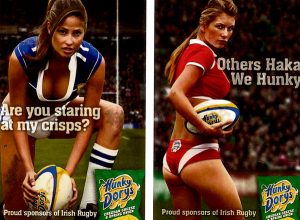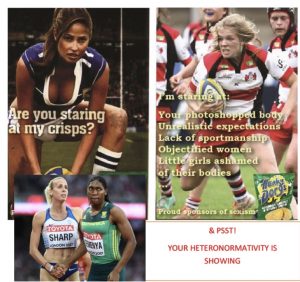Welcome to UBC Blogs. This is your first post. Edit or delete it, then start blogging!
GRSJ300 Culture Jam Ad

The decision to choose this ad is inspired by my personal experiences. I play a number of contact sports and I also avidly watch sports, so it would be safe to say that I defy gender norms. This ad, for Hunky Dory chips represents everything that’s wrong with the world today in terms of how women in sports are perceived. This attitude, of seeing the players as women first and athletes second, doesn’t start at the top either. When I first started playing sports, my mother tried to make me “cuter” when I went for games. She would be appalled when I returned from a morning run all muddy, hair plastered around my face with sweat. She also suggested my team that we all wear matching hair ties and “cute” ribbons when we go for games. This obsession with cuteness and femininity goes against the reality of women’s lives if they are involved in sports at a professional level. Sometimes, during heavy training and dieting months, the whole team wouldn’t even get their periods, so the heteronormative expectations of our gender seemed ridiculous to us. The ad is showcasing two scantily clad models wearing a wannabe rugby uniform, with focus on deep cleavage and buttocks as points of attention in the image. The ad emphasizes heteronormativity, explicit expectations of cuteness, hair and makeup, and gender roles, saying that women in sports are “hot,” and when the viewers see them, they should think of sex, not athletic performance.

Women’s sports programs are severely underfunded, and girls are not encouraged to participate in sports as much as men. What is more, women aren’t encouraged to play “rough” sports, like hockey or rugby because they are contact sports and can result in injuries which will make them less “pretty.” Women in sports often have to sign up with companies and do endorsements for products in order to get sponsored so they can train. It is obvious that the naturally attractive athletes are generally contacted by advertising companies. When these deals are put into place, the athletes are invariably turned into “girls,” or sex symbols, which are meant to appeal to a largely heteronormative audience which wants to see women in prescribed gender roles. What is more, it is usually the white or racially-uncertain (perceived as exotic) women athletes who are mostly featured in advertising because everyone wants to see pretty Caucasian girls half-naked in ads. My deconstructed ad is showing the reality of women’s sports, which is often not pretty at all, because many sports are very intense. There is no perfect hair and makeup, there is no overwhelming racial homogeneity and oftentimes there isn’t even gender dualism or clear sexual orientation. Women athletes don’t showcase their breasts or their buttocks to sell seats or gather fans. They work hard, train hard, and often develop muscles or other body traits which render them genderless or at least not visibly feminine. Women athletes also don’t participate in sports in order to sell products, and don’t intend to become commodities which are used by the advertising companies to lure in consumers. Finally, women athletes want to inspire young girls to pursue a career in sports in spite of difficulties and gender expectations, so my jammed ad represents the reality of female sportsmanship.